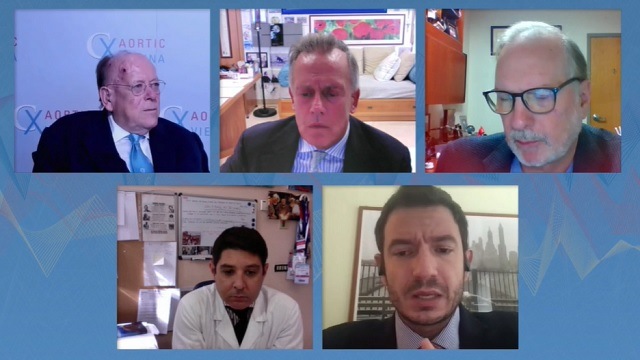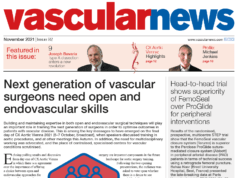
The specialist aortic team from San Raffaele Hospital (Milan, Italy), led by Roberto Chiesa, gave global CX Aortic Vienna 2021 (5–7 October, broadcast) attendees expert insights into their patient-centric approach to thoraco-adbominal aortic aneurysm (TAAA) reconstruction, encompassing both open and endovascular techniques.
All sessions are available to view on demand. Click here to register and access the recordings.
Reprising the How To Do It (HTDI) session from CX Aortic Vienna 2020, during which Chiesa’s Milan team offered techniques and tips for the treatment of aortic arch reconstruction, Daniele Mascia, Enrico Rinaldi, Andrea Kahlberg and Luca Bertoglio outlined tactics for treating some of the most challenging TAAA cases. The discussion—which included participation from a worldwide audience, participating from Australia to Zürich—was marshalled by Chiesa alongside his session co-chair Joseph Bavaria (Philadelphia, USA).
Mascia opened the one-hour session with a presentation detailing surgical technique for TAAA standard open repair. He noted that this approach was first employed over 30 years ago with the best results having been seen in high-volume centres. While improvements have been possible due to adjuncts added over time, he commented that surgical skill remains the most important factor.
Mascia noted that TAAA remains a hard surgery, with “not negligible morbidity and mortality”, which he said underscores the need for centralised high-volume centres and specialised aortic teams.
Questions were put to Mascia from across the globe, including Ahmed Soliman (Cairo, Egypt), and Simon Green (Brisbane, Australia). Session chair Chiesa asked Mascia for his view on the future of standard open TAAA repair surgery in light of advances in endovascular techniques. Mascia commented that while results of endovascular repair are “more and more encouraging”, a fact he attributed to increased operator experience and improvements in technologies, open repair is likely to remain the gold standard option in at least two situations, including in genetic syndromes and following endovascular failure.
Rinaldi then offered a detailed overview of the San Raffaele team’s strategy for organ protection during open surgery, describing the team’s “multisystem” approach encompassing the heart, spine, lungs and kidneys. Analysis of procedures performed within the centre from 1988–2009 and 2010 onwards appear to have significant improvements in perioperative mortality and spinal cord ischaemia over time, he detailed.
Rinaldi’s presentation elicited discussion from Jan Heyligers (Tilburg, The Netherlands) and Alice Lopes (Lisbon, Portugal), covering topics including carotid artery stenosis, approaches in ruptured TAAAs, and spinal cord embolisation. Rinaldi was asked for his view on where new adjuncts may be needed for organ protection, commenting that respiratory complications are among the most important areas for development.
Andrea Kahlberg presented tips and tricks in open conversion after thoracic endovascular vascular aortic repair (TEVAR), commenting that open conversions represent around 10% of surgeries performed. He added that these are particularly challenging cases, and occur due to progression of the disease or for stent graft related causes.
Responding to questions from Victor Bilman (Belo Horizonte, Brazil) and Andrew Robinson (Glasgow, UK), Kahlberg was asked for his view on whether endovascular techniques would eliminate the need for open surgery for any situation, including conversions. Kahlberg responded that the answer to the question is “easy, because it is impossible to avoid the need of open conversion,” adding that it is parallel to the expansion of endovascular techniques.
Bertoglio gave the audience insights into endovascular management of late complications of open TAAA repair, including intercostal and visceral patch aneurysm, presenting a case involving perioperative occlusion of the left renal artery. He told the audience that fenestrated or branched EVAR for visceral patch aneurysm is feasible, commenting that “bridging stents are pushed to the limits, but I think it is the gold standard”. Audience questions from Mumbai, India and Rio de Janeiro, Brazil closed out the session.
This session is available to view on demand. Click here to register and access the recordings.












